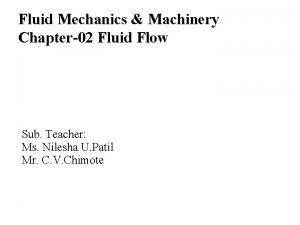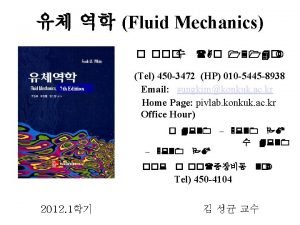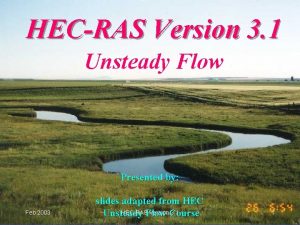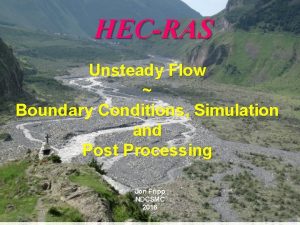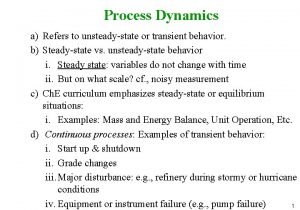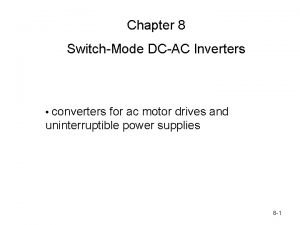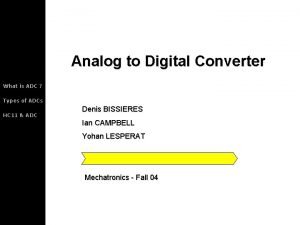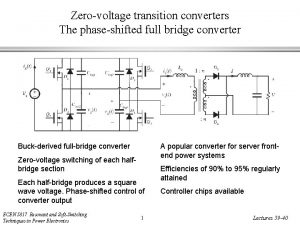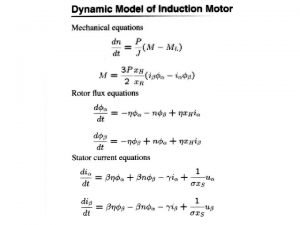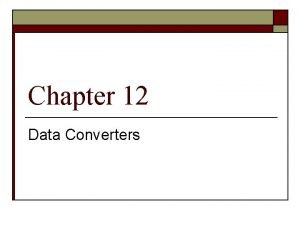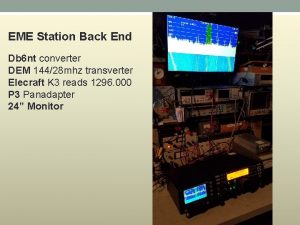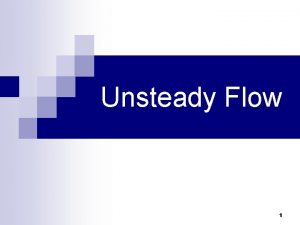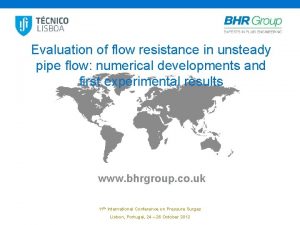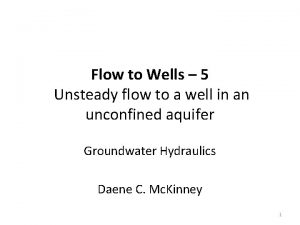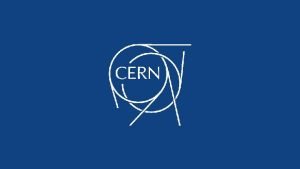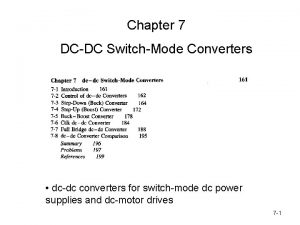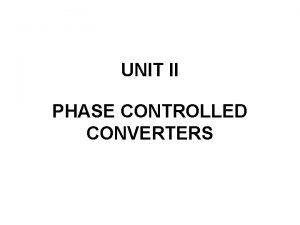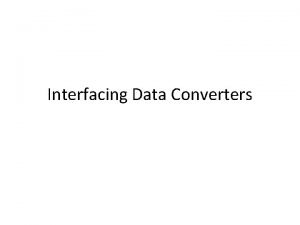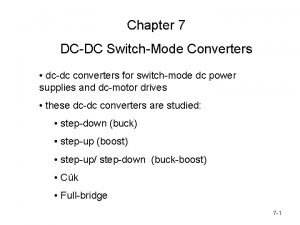Simulation of Marine Energy Converters in Unsteady Flow













- Slides: 13

Simulation of Marine Energy Converters in Unsteady Flow using Vortex Particle Methods Danny Sale and Alberto Aliseda Northwest National Marine Renewable Energy Center Dept. of Mechanical Engineering University of Washington Proceedings of thend 2 Marine Energy Technology Symposium METS 2014 April 15 18, 2014, Seattle, WA

Introduction • Design & analysis tool for single MEC devices • capture unsteady forces caused by atmospheric turbulence & rotor wake interaction • recover pressure distribution for structural analysis • blades with complex geometry (built in curvature, winglets, bio inspired) • Scalable computational framework • should run on laptops/desktops, up to distributed memory computers • eventual capability to model farm scale hydrodynamics

Methods: Viscous Vortex Particle Methods • Velocity Vorticity formulation of Navier Stokes equations • Particle Discretization • ODEs for Particle Trajectories & Strengths • Helmholtz Decomposition [1] Cottet and Koumoutsakos, Vortex methods: theory and practice, Cambridge University Press, 2000.

Methods: Viscous Vortex Particle Methods Resolve the RHS of vorticity transport at scales relevant to Marine Energy Converters Particle Strength Exchange (PSE) algorithm [2] • “mesh free” method • RHS transformed into integral approximations (Green’s functions – leads to more Particle interactions) • velocity calculated by Particle interactions Biot Savart O(N 2) but accelerated by GPGPU Vortex-in-Cell (VIC) algorithm [3, 4] • • combines particles and meshes RHS calculated w/ finite difference methods on mesh velocity calculated by Poisson Equation long range interactions on mesh via FFT solver reduces to O(Nlog. N) particles and mesh communicate w/ M 2 P, P 2 M interpolation high order and conservative [2] Winckelmans and Leonard, “Contributions to Vortex Particle Methods for the Computation of Three dimensional Incompressible Unsteady Flows, ” Journal of Computational Physics, vol. 109, no. 2, pp. 247– 273, Dec. 1993. [3] Rasmussen, Cottet, and Walther, “A multiresolution remeshed Vortex In Cell algorithm using patches, ” Journal of Computational Physics, vol. 230, no. 17, pp. 6742– 6755, Jul. 2011. [4] Hejlesen, Rasmussen, Chatelain, and Walther, “A high order solver for the unbounded Poisson equation, ” Journal of Computational Physics, vol. 252, pp. 458– 467, Nov. 2013.

Vortex Rings • Benchmark problems • • Comparison with analytical solutions & experiments Verify accurate treatment of stretching & viscous terms Develop mesh & “mesh free” visualization techniques Fun to watch

Vortex Rings • (LEFT) Solid boundaries modeled by ‘image particles’, satisfying “wall slip” Neumann BC • (RIGHT) Testing breakup and decay of concentrated vorticity

Simulation of Hydrokinetic Turbines • Added lifting lines to PSE code • Turbine specifications based on DOE Reference Models • Basic rotor speed and pitch control capability • Relies on lookup of 2 D airfoil data (Cl, Cd, Cm, Cp_min)

Synthetic Turbulence • Inject vortex particle representation of synthesized turbulent velocity field • Energy spectrums characteristic of oceanic flows (py. Turb. Sim code tidal version) • Key assumption: “Taylor's frozen turbulence”

Immersed Boundary Method • Add Brinkman penalization term to Vorticity Transport Equation • Brinkman penalization models solid boundaries ‘in the limit’ of zero porosity • Satisfies “no slip” boundary conditions at fluid solid interface • Immersed boundary greatly simplifies dealing with meshing [3] Rasmussen, Cottet, and Walther, “A multiresolution remeshed Vortex In Cell algorithm using patches, ” Journal of Computational Physics, vol. 230, no. 17, pp. 6742– 6755, Jul. 2011.

Immersed Boundary Method • NACA 4415 wing using 3 D VIC method with Brinkman penalization

Immersed Boundary Method • NACA 4415 wing using 3 D VIC method with Brinkman penalization • chord Reynolds = 2000, 256 x 128 mesh, simulate 20 s physical time, dt=0. 1 s • Run on single CPU, ~8 hour runtime, ~30 Gi. B data (velocity & vorticity fields)

Summary & Conclusions • Progress to Date • Developing viscous vortex particle methods (PSE and VIC algorithms) • Matlab and Fortran + PPM Library implementations • Benchmark problems (vortex rings, lifting lines, bluff body flows … ) • HAWT and VAWT with basic rotor/pitch control & synthetic turbulence • Immersed boundary method allowing generalized 3 D geometry • Future Enhancements • Add moving 3 D geometry in immersed boundary method (IBM) • Need to achieve flow with higher Reynolds • Continue with massively parallel version based on MPI and Open. CL • Combine PSE and VIC methods to include more flexible boundary conditions • Need more efficient resolution in near field of immersed boundaries

Thank you! Questions? Suggestions? This work has also been made possible by: • National Science Foundation Graduate Research Fellowship under Grant No. DGE 0718124 • University of Washington, Northwest National Marine Renewable Energy Center • Department of Energy, National Renewable Energy Laboratory Special thanks to Johannes Tophøj Rasmussen and Mads Mølholm Hejlesen for guidance with PPM Library code and FFT Poisson solver
 Steady flow diagram
Steady flow diagram Fluid
Fluid Steady vs unsteady flow hec-ras
Steady vs unsteady flow hec-ras Hec ras boundary conditions
Hec ras boundary conditions Aliran steady dan unsteady
Aliran steady dan unsteady Automatic control
Automatic control Weak and unsteady
Weak and unsteady Dcac converters
Dcac converters What is adc ?
What is adc ? Redox reaction in catalytic converters
Redox reaction in catalytic converters Zero voltage switching waveforms
Zero voltage switching waveforms Dcac converters
Dcac converters Digital to analog converters basic concepts
Digital to analog converters basic concepts Eme converter
Eme converter
